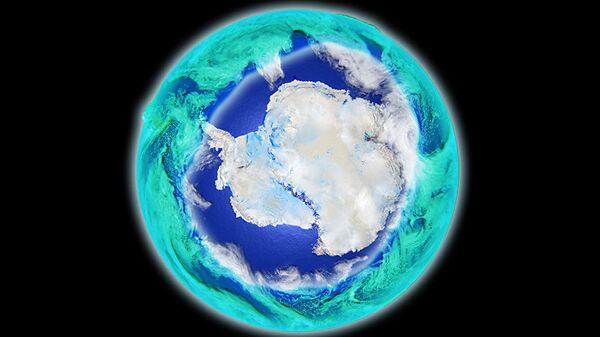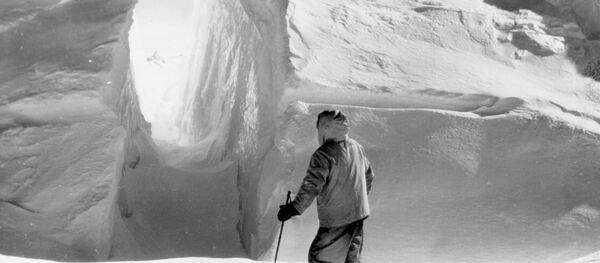Scientists from Siberian Federal University have recently used satellite data in order to analyze ozone concentrations in the northern hemisphere to come up with a new theory of how the Antarctic ozone hole formed. Their findings were published in the Journal of Siberian Federal University.
Atmospheric ozone forms a layer above the Earth’s atmosphere. This layer, about 90 km thick, absorbs ultraviolet radiation. Since this radiation is extremely harmful to proteins and nucleic acids, any decrease in the concentration of ozone in the atmosphere presents a great danger to all life on Earth.
The total column amount of ozone at any given point is measured by the level of absorption and scattering of solar radiation in the UV-band. The total ozone in the atmosphere is measured in Dobson units (DU). 100 DU forms a 1 mm layer of ozone. The average total ozone content on Earth was estimated at about 300 DU.
READ MORE: 'Ozone Friendly' Chemicals Actually Damaging to Ozone Layer
The levels of ozone in the Earth’s stratosphere change throughout the year. Large amounts of ozone are produced as a result of photochemical reactions in the stratosphere over the tropics and mid-latitudes. In spring, the ozone from the tropics flows toward the mid-latitudes and high latitudes. That is why in October and November scientists record the annual maximum levels of ozone in the southern hemisphere.
Between January and July, the ozone levels there are very low, because between December and April, the high and mid-latitudes are exposed to the sun.
It contributes to ozone depletion in a range of photochemical reactions which are catalyzed by various compounds in the atmosphere.
Ozone holes became an issue of global concern in the second half of the 20th century. Scientists discovered the long-term trend in decreasing total ozone, and a seasonal trend – which took place in October and November – in the formation of the famous Antarctic ozone hole.
This gave rise to the theory of anthropogenic ozone depletion. In 1973, during a laboratory experiment, American chemists discovered that the degradation products of chlorofluorocarbons (freons) could be the ones destroying the ozone layer. These findings were also used to explain the formation of the Antarctic ozone hole.
In 1987, the leading world powers signed the Montreal Protocol, a treaty designed to stop the production and use of chlorofluorocarbons, which served primarily as refrigerants. As a result, most refrigerators and air conditioners in the world had to be upgraded. In 2016, scientists discovered the new refrigerants to be greenhouse gases as well. This caused the protocol to be amended and a new ban to be issued.
Moreover, the chemists’ theories and mathematical models cannot be tested in the Antarctic environment. Upon the signing of the Montreal Protocol, the scientists said that the ozone hole in the Antarctic was to recover by 2010. However, this hole still appears every year. In 2017, its size was estimated at 22,000,000 square kilometers – a number which has remained the same for the past 25 years.
The new method of monitoring the movement of air currents, suggested by the researchers from Krasnoyarsk, allowed scientists to answer a number of questions on the nature of ozone hole formation. The new model of formation of this ozone anomaly in the southern hemisphere was developed based on the analysis of physical phenomena taking place in the atmosphere.
“It just so happened that this geophysical problem – the state of the Earth’s ozone layer – got into the hands of atmosphere chemistry experts instead of geophysicists and meteorologists, and still is believed to be a chemistry issue,” said Valentin Kashkin, professor at the Siberian Federal University’s Institute of Engineering Physics and Radio Electronics and one of the authors of the research. “Unfortunately, all research on the
Antarctic ozone hole is aimed at proving the anthropogenic nature of its formation. In order to do this, they are suggesting various chemical and photochemical reactions, constructing mathematical models. At the same time, however, they are ignoring a significant amount of geophysical data.”
According to a different theory, the Antarctic ozone hole was formed naturally due to dynamic processes taking place in the Earth’s stratosphere. All scientists had to do to prove it was to use the total ozone data, which has been recorded by the Earth’s artificial satellites since 1978.
READ MORE: US Environmental Protection Agency Head Proposes Limit on Ozone Emissions
Like other atmospheric formations, ozone has a cloud structure. By comparing satellite data recorded on two consecutive days, one will be able to figure out the direction and travel speed of ozone clouds from their movement.
As it turned out, in the beginning of September ozone flows from the South Pole toward the equator. It moves along a spiral trajectory, spinning fast from west to east, to eventually form a ring by 45° latitude. Then ozone is redistributed between the ring and the ozone hole. The ozone levels in the ring itself go up; while on the inside of the ring the total ozone levels go down, thus forming the Antarctic ozone hole.
What is an ozone hole? It is a “hollow” in the ozone layer of the southern hemisphere’s polar latitudes, which has abnormally low levels of total ozone. The Antarctic ozone hole is surrounded by a “ring,” which is several thousand kilometers in diameter and has abnormally high levels of total ozone (up to 450 DU) for the southern hemisphere.
Starting in mid-October, the ozone hole starts filling up with ozone flowing back from the ring and the tropical latitudes. The analysis of digital maps allowed scientists to monitor the movement of ozone from the pole toward the equator and back again, its movement in the direction of east and west, and to assess its speed of movement as well.
In the southern hemisphere, September and October is the time when the ozone from the tropics starts flowing toward mid-latitudes. Scientists have also discovered a new ring at 35° south latitude, which formed as a result of the ozone movement. This ring is located near the latitude of Buenos Aires and Cape Town. Finally, the ozone movement also forms a third ring at 80° south latitude.
Scientists from Siberian Federal University developed a new method of analyzing the so-called zonal averages. It will allow them to make more accurate predictions concerning the total ozone levels for years to come. The zonal average tables are available on the internet. In order to draw up such a table, scientists take the total area of the globe from pole to pole, divide it into rings with a width of 5° each and calculate the total ozone levels in each of them.
“A year before the Montreal Protocol entered into force, NASA employees analyzed zonal averages to discover that the levels of ozone between 1979 and 1982 in the direction from 44° south latitude to the South Pole had barely changed between August to November, and the decrease in its levels by the South Pole in September was followed by an increase in the mid-latitudes.
“These results showed that the variations in the ozone levels were caused by dynamic redistribution of ozone, not by any chemical processes. This theory, however, undermined the anthropogenic theory of ozone layer depletion and ozone hole formation. The then scientific community would not have welcomed findings like this, since the case was, basically, closed.
“But the history of the dynamic theory was not over: we were able to answer a number of questions related to the formation of ozone holes. Namely, we used a large amount of data to show that the amount of ozone that was caught in the polar vortex coincided, with an accuracy of at least 5 to 7 percent, with the amount of ozone that flowed out of the Antarctic ozone hole. Our team presented these findings not only in journal articles, but also in the monograph published by Siberian Federal University,” Kashkin said.


